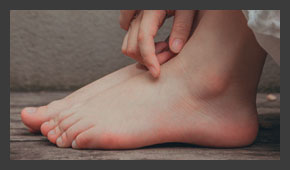The feet are responsible for handling a lot of force and weight throughout the duration of our lives and constantly take a lot of daily abuse from walking, running, jumping, and climbing. It comes as no surprise that the foot injuries and inflammation we experience leads to several different types of damage and malfunctions. Improper footwear, diabetes, and aging are some of the leading causes of foot problems. Here are some common foot problems you may experience as well as how to manage them if they arise:
- Athlete’s foot - Athlete’s foot is a fungal infection of the skin, usually found between the toes. This infection can spread and cause significant discomfort, itching, and even pain. Being exposed to the fungus that causes athlete’s foot commonly happens in a gym, shower, or pool where people walk around barefoot. Lower your risk by keeping your feet and toes clean and dry, changing your shoes and socks regularly, and never walking barefoot in public locker rooms and showers.
- Hammertoes - If your second, third, or fourth toe is crossed, bent in the middle of the toe joint, or just pointing at an odd angle, you may have a hammertoe. Ill-fitting shoes contribute to the formation of hammertoes. If your toe is still flexible, we suggest that you wear roomier, more comfortable footwear or try inserts or foot pads that can help reposition your toe.
- Blisters - Most blisters are caused by friction between the skin on the foot and the inside of your shoes and result in raised fluid-filled pockets, not generally a serious concern. It is best not to burst blisters, letting them heal on their own. Simply cover it with a bandage and allow it to burst naturally.
- Bunions - Bunions are abnormalities of the feet that cause a bump to develop on the large toe joint. Bunions can result from congenital deformities, arthritis, trauma, heredity, or habitually wearing shoes that are too narrow in the toe. Treatment for bunions may include wider shoes, padded shoe inserts, and over-the-counter pain relievers.
- Corns and calluses - Corns and calluses form after repeated rubbing against a bony area of the foot, usually by shoes that don’t fit well. Corns can appear on the tops and sides of your toes as well as between your toes, while calluses tend to form on the bottoms. You can typically treat them yourself by removing the buildup of skin, soaking the affected area in warm water until the skin softens and using a wet pumice stone to remove the dead skin.
- Plantar Fasciitis - This condition occurs when the ligament, called the fascia, that connects the ball of the foot to the heel becomes inflamed. Treatments include resting the foot and applying ice, and physical therapy to learn stretches to reduce the tightness in the medial band of the foot. Fewer than 10 percent of the people with plantar fasciitis require surgery to treat the condition.
- Claw Toes and Mallet Toes - A claw toe curls upward at the joint where the toes and the foot meet and downward at the middle and end joints of the toe, making the toe look curved, or clawlike. While tight shoes can be blamed for claw toes, so can nerve damage to the feet which weakens foot muscles. Buying shoes with more room in the toes, filing down corns and calluses, and padding, taping, or strapping the toe most often relieve the pain.
- Gout - Gout is a type of arthritis caused by a buildup of uric acid in joint tissues and joint fluid, which happens when the body is unable to keep uric acid levels in check. Although gout isn’t a foot condition, typically one of the first places this buildup occurs is in the big toe joint. Medications for gout are designed to reduce pain or control the body’s production of uric acid to limit the frequency of attacks.
- Ingrown Toenails - This is when the toenail starts to grow into the nail groove, which can cause significant pain and discomfort. Wearing badly-fitting shoes usually causes ingrown toenails from pressure when shoes are too narrow at the top or too tight. Try soaking the toe in warm water for 15 or 20 minutes several times a day and tucking a small piece of cotton or dental floss under the ingrown edge of the nail to encourage it to grow away from the skin.
- Toenail fungus - Toenail fungus often forms after damage to the nail that causes the nail-skin junction, where the nail meets the skin of the toe, to be disrupted. Toenail fungus can give nails an unattractive, deformed appearance. Treating toenail fungus can be difficult, as it often comes back even after successful treatment. You may want to consider seeking options such as taking a prescription antifungal medication.
Written by
Dr. Jeffrey S. Hurless
DPM, FACFAS Board Certified Foot & Ankle Surgeon/Podiatrist
Medical Director, HealthyFeetStore.com
 |
 |
